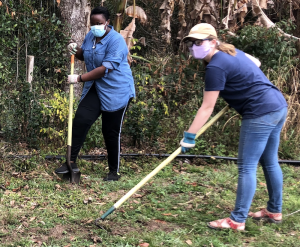When it comes to sustainable agroecosystems, cover crops are a key component. However, choosing whether a single cover crop or a mixture will provide growers with the right nutrients needed for the cash crop they are planting is still up for debate. New research from the UF/IFAS Department of Soil, Water, and Ecosystem Sciences (SWES) examined soil nitrogen (N) mineralization of several commonly used cover crops in the field and the lab.
“This project aimed to understand patterns of nitrogen release of cover crop monocultures and mixtures over time in a subtropical vegetable production system,” said Precious Nyabami, a recent SWES Master of Science graduate. The research was the focus of her thesis.

Nyabami conducted a litterbag study and an incubation study to assess nitrogen release from cover crops. She selected different cover crop mixtures using sunn hemp, cowpea, sorghum Sudan grass, and millet. Mixtures included one legume and one grass variety and then all four cover crops together. For the second year, she focused on assessing the potential soil health benefits of the cover crops in a vegetable production system.
Research Results
“We found that mixtures of cover crops did not immobilize nitrogen. However, they provided the potential for obtaining both high biomass production and nitrogen delivery to the subsequent crop,” Nyabami said. “The residue mixtures enhanced nitrogen release in the first two months of decomposition. The type of grass species in the cover crop mixture was the driver of when that N was released.”
She adds that decomposition and N loss are fast in Florida, “by four months, more than 80% of nitrogen from cover crops is lost.” Therefore, growers need to give careful consideration when selecting a species of grass for their cover crop mixture.
Dr. Yang Lin, assistant professor of soil health, was Nyabami’s faculty advisor.
“Precious’s research shows that nitrogen is quickly released from cover crop mixtures. Also, mixing grass and legume cover crops further accelerated that loss,” Lin said. “While this research focused on vegetable systems, we would expect rapid nitrogen loss in other agroecosystems in Florida, such as row crops and forage systems.”
You can see the full research article in the journal Plant and Soil here: https://link.springer.com/article/10.1007/s11104-023-06183-4
The VoLo Foundation awarded Nyabami the 2022 Vista Award for her graduate research. In particular, the Foundation was interested in the ability of cover crops to sequester carbon. The award came with a $10,000 prize she used to further develop the project. Nyabami also presented her research at the VoLo Foundation’s Climate Correction™ conference in March 2022.
 4
4
